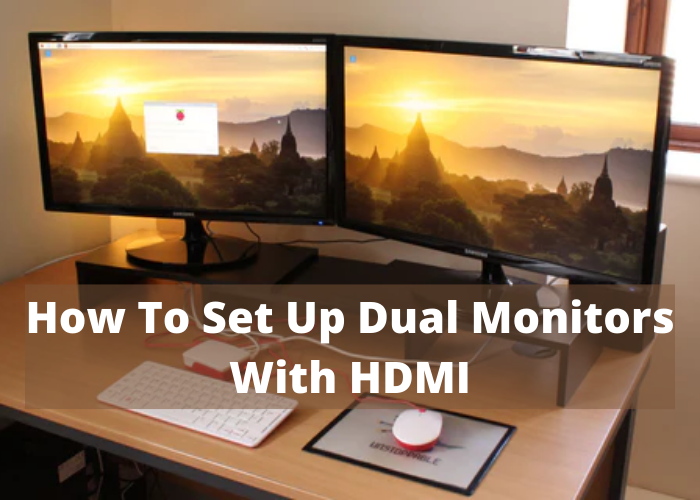Are you looking for an easy way to set up dual monitors with HDMI? If so, you’re in luck! In this blog post, we will show you how to set up dual monitors with HDMI in Windows. We will also provide some tips on how to get the most out of your dual monitor setup. Let’s get started!
What You’ll Need
If you work at a computer all day, you may find that a single monitor just doesn’t give you the space you need to be productive. Luckily, it’s easy to set up dual monitors with an HDMI connection. All you’ll need is a second monitor, an HDMI cable, and a computer with an HDMI port. Once you have all of the necessary components, simply connect the HDMI cable to both the monitor and the computer. Then, power on the monitor and your computer should automatically detect the new display. You can then adjust your settings to make sure that both monitors are displaying correctly. With dual monitors, you’ll have plenty of space to multitask and stay productive all day long.
Setting up Your Computer
HDMI is the latest standard for high-definition multimedia interfaces. If you set up dual monitors with HDMI, you’ll be able to enjoy the best multimedia experience possible. Here’s what you need to know about HDMI and how to set up dual monitors with it.
HDMI is a digital interface that supports high-definition video and audio. It’s the latest standard for home theater systems, and it’s also becoming increasingly popular for computer setups. If you have an HDMI-equipped monitor, you can use it as your primary display or as a secondary display. Most computers these days come with HDMI ports, so it’s easy to add a second monitor to your setup.
To set up dual monitors with HDMI, you’ll need two HDMI cables and two monitors that support HDMI. Connect one end of each cable to the appropriate port on each monitor. Then connect the other end of each cable to the HDMI port on your computer. Once everything is plugged in, you’ll need to configure your computer’s display settings to extend your desktop across both monitors. This process will vary depending on your operating system, but it’s typically very straightforward.
Connecting the Monitors
Do you want to work more efficiently or just have more screen real estate? You can do both by connecting two monitors to your Windows 10 computer. The process is simple and only takes a few minutes to set up.
Before you start, you’ll need to gather a few things. First, you’ll need two monitors. Make sure that both monitors support HDMI connections. You’ll also need an HDMI cable long enough to reach from one monitor to the other. Finally, you’ll need a PC that supports dual monitors. Most laptops and desktops released in the last few years support dual monitors, but it’s best to check with your manufacturer to be sure.
Once you have everything you need, connect one end of the HDMI cable to the back of each monitor. Then connect the other end of the cable to your computer’s HDMI port. If you’re using a laptop, you may need to use an adapter for this step. Once everything is connected, turn on both monitors. By default, Windows 10 will extend your desktop across both screens. This is ideal for most users, but if you prefer, you can also choose to duplicate your desktop or use one monitor as a primary display.
Adjusting the Settings
If you’re looking to increase your productivity by using two monitors, you’ll need to make sure that your computer is configured properly. First, you’ll need to identify whether your computer has the necessary ports for connecting a second monitor. Most computers will have either HDMI or DVI ports, but some older models may only have VGA ports. If your computer only has VGA ports, you can still connect a second monitor by using a VGA-to-HDMI adapter. Once you’ve determined that your computer has the appropriate ports, simply connect the first monitor to your computer using an HDMI or DVI cable. Then, connect the second monitor to your computer using either another HDMI or DVI cable, or a VGA-to-HDMI adapter. Finally, open the Display Settings menu and configure the monitors to extend your desktop. With dual monitors set up, you’ll be able to take full advantage of increased productivity.
Final Thoughts
With two monitors, you can keep all of your email, chat, and web browsing tabs open on one screen while you use the other screen for more demanding tasks like photo or video editing or writing long documents. You can also use one monitor for work and the other for leisure— coding on one screen and streaming movies or playing PC games on the other, for example. Or, if you’re a stock trader or online poker player, you can have multiple screens going at once so you never miss a beat. Setting up dual monitors is relatively simple, but there are a few things to keep in mind before you get started. First, you’ll need to make sure your computer has the right hardware— most laptops nowadays do, but desktop computers might require a bit of an upgrade. Second, you’ll need to decide which ports you’re going to use to connect your monitors. HDMI is the most popular choice these days, but older computers might only have DVI or VGA ports. Lastly, you’ll need to figure out which monitor will be your primary display and which will be your secondary display. This can be important for things like setting up extended or mirrored displays.

